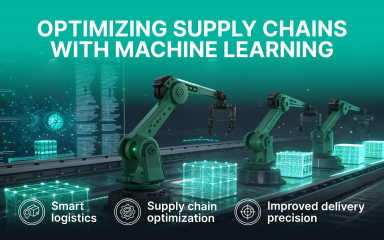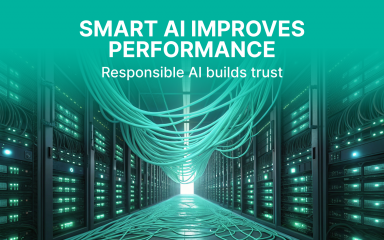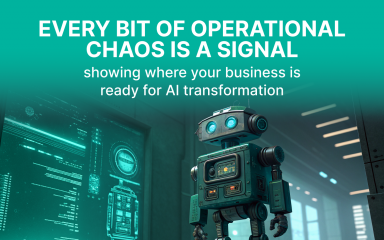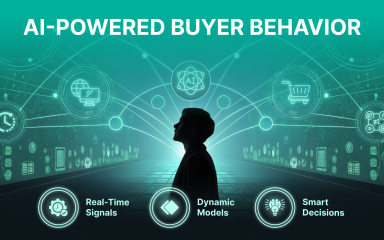Attention Mechanism in eCommerce: Real AI Use Cases
Let’s discuss attention. Not the kind you beg for in meetings—this one lives in algorithms, guiding AI to figure out what matters most. Powered by deep learning and machine learning, attention mechanisms have become foundational technologies in modern AI. If you’ve ever seen Netflix predict your weekend binge or Amazon somehow “know” you need new running shoes, there’s a good chance an attention mechanism was quietly working behind the scenes.
This tiny yet mighty concept is changing the way eCommerce platforms deliver personalized experiences. It’s what helps AI focus (pun intended) on the correct information—like your behavior, preferences, or even the time you shop—to make smarter, more relevant suggestions across different channels and listings. Neural networks are the underlying structure enabling these advanced capabilities in today’s eCommerce platforms. And brands know this. In fact, 89% of marketing decision-makers say personalization is essential to their success.
So let’s break this down—plain English, no jargon—and see how this mechanism works and why it’s one of the smartest moves in modern eCommerce.
What Is an Attention Mechanism, Context Vector, and How Does It Work?
Here’s the thing: AI used to process all data equally, kind of like a student who highlights every sentence in a textbook. Effective? Not really. Before attention mechanisms, models like recurrent neural networks (RNNs) with recurrent connections were commonly used for sequence modeling, but they had limitations in capturing long-range dependencies and contextual details.
The attention mechanism changes that. It’s a way for AI models, especially transformer attention mechanism models like GPT or BERT, to assign importance to different pieces of input. The transformer model revolutionized the field by enabling models to process sequences in parallel and focus on relevant information, unlike previous models. In other words, the AI can now “pay more attention” to the parts that matter most in context.
When the model processes input, each input token or word is first converted into a vector by an embedding layer. The position of each token is encoded using positional encoding, so the model understands the order of input tokens—such as which one word comes before another—helping it capture sequence information.
Say you search for “wireless headphones for running.” Without attention, the model might pull in results from every headphone ever. With it? It picks up on what’s essential—wireless, for running, not studio gear—and ranks results accordingly using smart content cues and behavioral analytics. The model turns each input into a hidden representation, then uses the attention mechanism to score how important each word or token is, assigning weights based on their relevance in context.
Think of it like this: the model first turns each word or input into a set of numbers—called a vector—using something known as an embedding layer. Then, it figures out which parts are most important by comparing these vectors using dot products (that’s the core of multiplicative attention).
In self-attention, the model looks at all parts of the input at once and checks how each part relates to the others—kind of like how a database matches queries to the right data using keys. Finally, the model takes all these importance scores and uses a softmax function to turn them into probabilities, helping it decide where to focus most.
In additive attention, the context vector is formed by combining the encoder’s hidden states, giving more weight to the important ones—based on how well they match the decoder’s current state, which acts as the query. The mechanism helps the model focus on relevant information and the relative importance of each element in the sequence, capturing fine details and detail in the input for improved performance.
Transformer-based models use a linear layer to project token vectors into the vocabulary space, and parallel computing enables efficient training of these large models. There are many variants of attention mechanisms, each suited to different tasks. For example, in neural machine translation, attention helps generate a translated sentence by aligning source and target words. Attention is also applied in sentiment analysis, machine reading, and other NLP tasks, leveraging hidden states, previous hidden state, and encoder hidden state to capture context and meaning.
The Many Flavors: Types of Attention in AI
Not all attention mechanisms are created equal. Just like there’s more than one way to brew your morning coffee, there are several types of attention mechanisms in AI—each with its own recipe for focusing on the most relevant parts of your data.
Let’s break down the main flavors:
Additive Attention (Bahdanau Attention):Think of this as the “classic blend” in natural language processing. Additive attention computes a weighted sum of the input elements to create a context vector, helping the model zero in on the most important words or phrases in a sentence. It’s a go-to for tasks like machine translation and question answering, where understanding the relationship between different parts of the input sequence is key.
Multiplicative Attention (Dot Product Attention):This type uses the dot product between a query vector and key vectors to figure out which parts of the input deserve the spotlight. Multiplicative attention is especially popular in computer vision tasks like image recognition and object detection, where the model needs to quickly compare and focus on relevant features in the data.
Self-Attention (Intra-Attention):Here’s where things get really interesting. Self-attention allows a model to look at different parts of the same input sequence at once—kind of like reading a paragraph and instantly understanding how each sentence relates to the others. This is the backbone of transformer architecture (thanks, Vaswani et al), powering everything from language translation to speech recognition and even foundation models. Self-attention is what lets transformer-based models process input tokens in parallel, capturing context and relationships across the entire sequence.
Cross-Attention:When you need to connect two different sequences—like matching a source sentence to its translated version in machine translation—cross-attention comes into play. It’s a staple in encoder-decoder models, helping the AI align and focus on relevant parts of both the input and output data.
Specialized Attention Mechanisms:Depending on the type of input data, attention mechanisms can get even more specific. Spatial attention focuses on different regions in an image (great for computer vision), channel attention hones in on specific feature channels, and temporal attention tracks important moments in time-series data. Each is designed to help the model focus on the most relevant parts, whether it’s pixels, features, or time steps.
Choosing the Right Attention Mechanism:There’s no one-size-fits-all. The best attention mechanism depends on your task, your data, and what you want your model to focus on. Sometimes, combining multiple attention heads or jointly learning attention weights with other model parameters can boost performance even further.
In short, attention mechanisms are as diverse as the problems they solve. Whether you’re building a neural network for language translation, image captioning, or real-time decision making, picking the right type of attention—and tuning it for your data—can make all the difference.
How Attention Mechanisms Are Used in eCommerce
Now here’s where things get exciting—and, frankly, profitable. The attention mechanism in eCommerce is reshaping everything from how you discover products online.
Let’s break down where it makes an impact:
Intelligent Recommendations That Actually Make Sense
Ever feel like your shopping feed “gets” you? That’s attention-based AI in action. These systems analyze your interactions—searches, purchases, even hover time—to understand your taste and suggest products that fit. It’s not random. It’s personal. No surprise, then, that over 92% of businesses are already using AI in eCommerce personalization to fuel growth.
Ranking Products Based on Behavior, Not Just Popularity
Search used to be about keywords. Now, AI product ranking takes into account who you are, what others like you are buying, and what you’re likely to engage with next. Thanks to AI search optimization, results aren’t just accurate—they’re relevant and informed by live performance data.
Reading Between the Clicks
Behavioral data is noisy, right? But AI powered demand forecasting tools by an attention mechanism AI can filter through the mess to uncover subtle insights. This is where AI customer behavior analysis shines—predicting whether someone’s just browsing or seriously considering that $800 camera.
Smarter Chatbots That Actually Help
AI-driven customer support doesn’t just reply—it learns. Thanks to attention models, bots can interpret full conversations (not just keywords) and offer responses that feel human. Which, you know, is the dream.
Real-World Applications of Attention Mechanisms in eCommerce
Enough theory—let’s talk real-world impact. Businesses aren’t just experimenting with this tech—they’re scaling it using cutting-edge software and management platforms.
BytePlus ModelArk: Laser-Focused Personalization
BytePlus (TikTok’s AI engine) has built a recommendation engine that uses attention mechanism in recommender systems to drive micro-personalized experiences. Think of it like a digital concierge—one that understands you better with every click. The result? Higher engagement. And while tech like this is powerful, surprisingly few execs have fully embraced it—only 17% use AI/ML extensively, even though 84% see its potential.
Vantage Discovery: Rank Smarter, Sell More
Some platforms, like Vantage, are using attention-driven models to refine product rankings and improve average order value. By focusing on what users actually care about (not just what’s trending), they boost visibility for the right products—ones that convert.
Academic Muscle: Research Meets Retail
Researchers are also pushing this tech into new territory. Recent studies show that attention-enhanced AI models deliver better context-aware recommendations—essentially making product discovery more intuitive across platforms. So yes, the science backs the strategy.
Why It’s Worth It: Key Benefits for eCommerce Brands
Alright, let’s pause and take stock of the upsides. Why should a CMO or tech lead care about all this?
Because integrating an attention mechanism in eCommerce translates into very real wins:
- Sharper Personalization
AI systems become more intuitive—users feel seen, not stalked.
- Better Recommendations
No more guesswork. Personalized recommendations AI means fewer abandoned carts and more happy customers.
- Smarter Segmentation
AI doesn’t just see demographics—it sees patterns. That’s a game changer for campaigns and customer targeting.
- More Efficient Search
Not just faster, but more helpful. When AI knows what matters, it delivers better results without wasting a user’s time.
Challenges and What’s Next
Let’s not sugarcoat it—it’s not all plug-and-play.
Implementing AI attention mechanisms comes with its share of hurdles:
- It’s Technical.
This stuff isn’t simple to integrate. You need solid infrastructure and dev teams who know their way around modern ML models.
- It Needs Data.
Not just big data—clean, labeled, and diverse datasets. Think product reviews, click histories, and behavioral logs that reflect your audience accurately.
But the payoff? Huge.
Looking ahead, expect advances in multimodal models (think image + text), real-time personalization, and AI systems that can explain why they made certain recommendations. That last one—explainability—is big for trust and compliance, especially in regulated markets.
Wrapping Up: Why Attention Matters
The attention mechanism might sound like a technical footnote—but it’s fast becoming a cornerstone of AI in eCommerce.
It gives your platform a kind of sixth sense—one that can read context, pick up subtle intent, and shape the digital shelf in ways that feel effortless to the user.
So, if you’re aiming to improve user engagement, sharpen your product descriptions, or just make the most of your AI solution, it’s time to stop overlooking attention.
Because it’s not just a mechanism—it’s a strategy.











